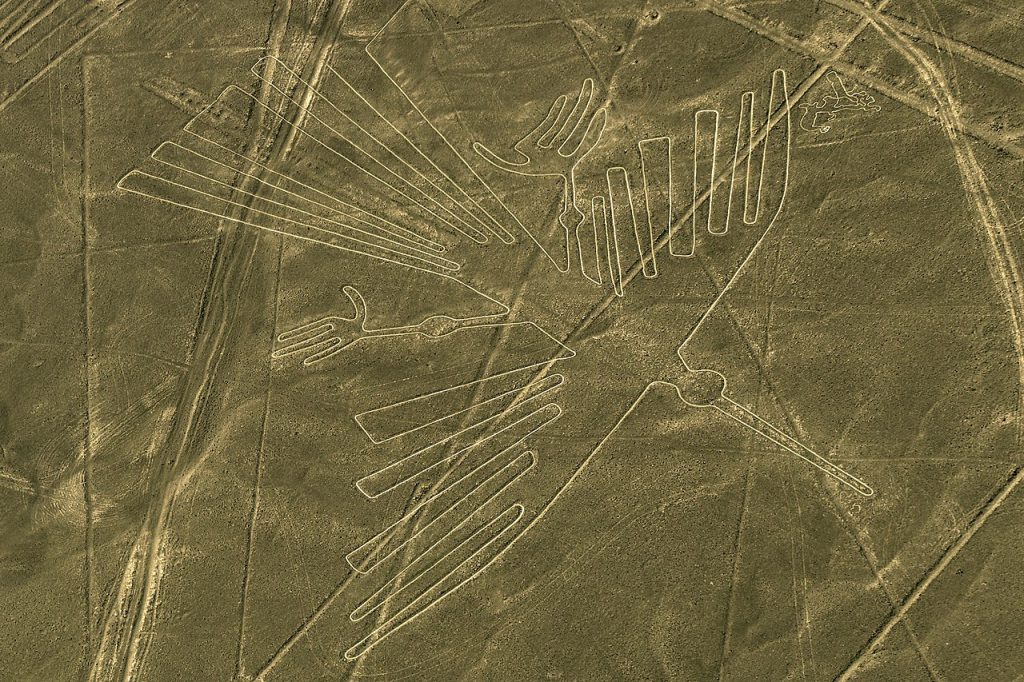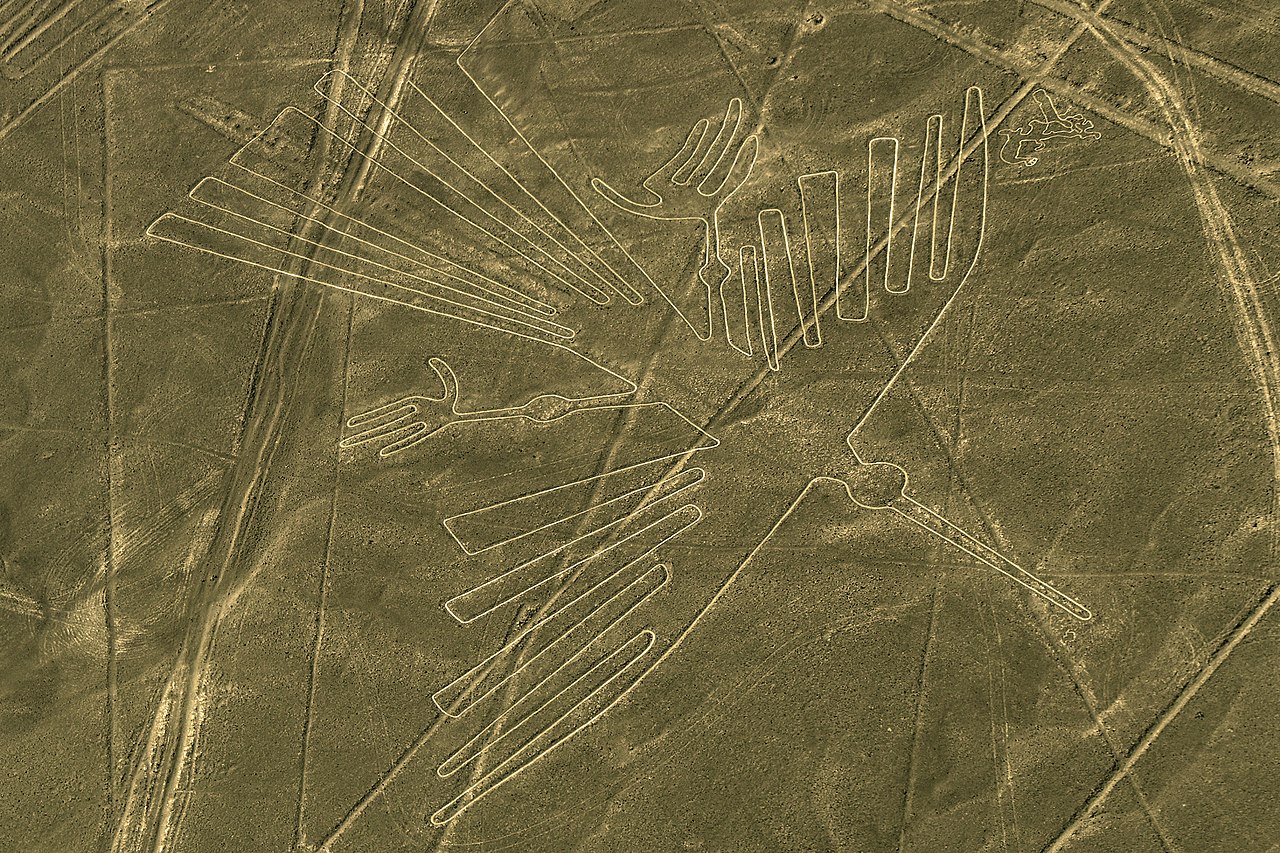We warmly welcome Ben Gagnon, author of Church of Birds, as our featured author this month. Ben’s book is an eco-history of human evolution supported by recent scientific discoveries, ancient myths, and sacred texts. Across dozens of cultures, migratory birds were seen as divine agents of a benevolent sun, delivering seeds to the landscape in spring and guiding souls to a heavenly paradise in the fall. Ben’s article explores how this role was honoured and encouraged through sacred sites worldwide. From the Nazca lines in Peru to the Temple of Karnak in Egypt, ancient sites around the world paid homage to the sky and the birds that carved their migratory paths through it.
You can interact with Ben on our AoM Forum here.
Amidst the chaotic social upheaval of 1968, Erich von Däniken’s Chariots of the Gods captured the imagination of the baby boomer generation by claiming that extra-terrestrials had once used the Nazca Lines in southern Peru as an airfield.
Despite serving a one-year term in a Swedish prison in 1970 for fraud and embezzlement, Däniken’s books have since sold 72 million copies and self-described ancient alien theorists continue to claim the Nazca Lines and other complex designs etched on high deserts by ancient cultures were signals for extra-terrestrials. Their argument is based on a seemingly confounding question: If the designs can only be seen from high in the sky, who else but aliens from other worlds were supposed to see them?
In short, the answer is birds.

Geoglyphs of the Americas plotted on a map of global bird migration flyways. (Courtesy of BirdLife International)
A route of the Pacific Americas Flyway passes directly over the Nazca Lines, where more than 300 geometric designs known as geoglyphs were created about 2,000 years ago, including four birds sacred to the Nazca: the Andean condor (a vulture), the hummingbird, the owl and the macaw. Throughout the Americas, geoglyphs like those at the Nazca Lines are typically found at high elevations where two global bird migration flyways overlap, producing a high population and wide variety of avian life.
Welcoming migratory birds in early spring was once a major event on the sacred calendar of cultures worldwide, based on the belief that they were emissaries of the sun that delivered the seeds of vegetation at creation and every spring thereafter. A 2016 study published in The Royal Society of Biology found truth in the mythic belief, identifying migratory birds as “vectors of seed dispersal” that deliver enough seeds to their seasonal grounds to substantially diversify the flora. Many avian seasonal grounds around the world are classified as hot spots of biodiversity.
The ritualized welcome of birds in early spring was held at sacred sites at high elevations, likely featuring drumming, music and bonfires at night to signal incoming birds. At the Nazca Lines, new evidence suggests high priests smashed pots full of live mollusks on stone altars, possibly to attract birds. The rituals may have included the piercing, bird-like music of flutes made from the bones of condors and pelicans, similar to those excavated up the Peruvian coast in Caral.

The Nazca Lines are marked with a blue dot on a route of the Pacific Americas Flyway. (Courtesy of BirdLife International)
The divinity of birds
The busiest bird migration corridor in Peru is where the Pacific and Central Americas flyways converge and run northwest-southeast, encompassing the Old Temple at Chavín de Huántar in the Central Andes, built about 2,850 years ago at an altitude of 10,335 feet. In the middle of a circular plaza in front of the Old Temple once stood the Tello Obelisk, carved from granite and bearing an image of a raptor dropping peanuts from the sky.
The same busy bird migration corridor encompasses Machu Picchu, the ancient city of Cuzco and the sacred Lake Titicaca before bearing due south over the mysterious Sajama Lines in western Bolivia and to an avian seasonal ground at Llullaillaco volcano, sacred to the Inca and earlier cultures.
Stone altars recently excavated at the Nazca Lines were surrounded by walls packed with the broken shells of crayfish, crabs and mollusks, along with fragments of pottery that were intentionally smashed, according to Johny Isla, director of the Andean Institute of Archaeological Studies, in a 2019 documentary episode of “Blowing Up History.” Isla believes the pots and mollusks were shattered as part of a ritual calling for rain to recharge the Nazca’s sophisticated aqueducts. Known as puquios, the distribution system included spiral holes to collect water, underground tunnels and small reservoirs. Some researchers believe the Nazca Lines serve as a map of the puquios.
In Peru, spring rains arrive in September at the same time seed-bearing migratory birds fly in from points north. Perhaps high priests at the Nazca Lines broke pots of live shellfish on the altars so the odor would attract sacred birds, hungry after their long journey. If the spring rains softened the arid ground, the seeds delivered by birds could grow.
Conflating migratory birds with spring thunderstorms is a cross-cultural phenomenon embodied by mythic beings such as the Thunderbird, dating back to the winged Ninurta of Mesopotamia, the god of storms and farming.
Attracting Andean condors

The Condor geoglyph at the Nazca Lines. (Roger Canals/Wikimedia Commons CC0)
Along with the well-founded belief that migratory birds delivered seeds in spring, numerous ancient cultures also believed vultures could carry the souls of the dead to a heavenly paradise.
Archaeological and anthropological evidence suggest both the Moche and Nazca cultures practiced sky burials that required attracting vultures to devour dead bodies, possibly arranged on altars. A double-spouted Nazca pot shows a vulture with its beak nipping the arm of a headless human. Emerging about 1,900 years ago in northern Peru, the Moche buried vultures with the elite and decorated pots with depictions of vultures escorting people to the underworld.
The vulture in question was the high-flying Andean condor, celebrated as an emissary of the sun god in Andean art for at least 4,000 years. With its 10-foot wingspan, the Andean condor migrates from the mountains and over the Nazca Lines to the coast in summer, attracted by the discarded placenta of breeding sea lions. Perhaps priests also smashed pots of shellfish on the altars at the Nazca Lines to attract scavenging condors to play their crucial role in sky burials.
Because sacred birds played such critical roles in the cycle of life and death, ancient cultures often incorporated them into ritual artwork. Emerging about 2,800 years ago along the coast of southern Peru, the Paracas culture bundled human mummies in clothing covered with birds in a checkerboard pattern. In the outstretched wings of each bird were human heads.
The mummy’s symbolic clothing was likely intended to help the soul transform into a bird/human hybrid to navigate the afterlife, according to anthropologist Anne Paul, author of Paracas Ritual Attire (University of Oklahoma Press, 1991). The Paracas also built geoglyphs that pointed to ceremonial mounds. Emerging about 2,300 years ago, just inland from the southern coast, the Nazca used similar symbols, including a ceramic vessel with tiny human faces painted on the wings of a bird.
Attracting birds to sacred sites
Because birds were perceived as a vital and necessary cog in the cycle of life, death, and rebirth, leaders across the ancient world were bound to guarantee the annual migration cycle would continue. Pharaohs and kings spent enormous amounts of time and treasure building sacred sites in part to attract birds.
The Temple at Karnak in Egypt featured a shallow pool bigger than a football field for the Sacred Geese of Amun, a peaceful spot for birds to rest and refuel along the Nile’s busy bird migration route. Greek and Roman temples around the Mediterranean featured pools, fountains and gardens inhabited by domesticated waterfowl that were considered sacred.
From Europe to India, Cambodia and Japan, temples and tombs incorporated water features into designs that stood out in sharp contrast to the natural landscape from a bird’s eye view. With its vast rectangular pool and extensive flower gardens, the Taj Mahal in India is hard to miss from above and a truly inviting habitat for migratory birds passing by on a route of the Central Asia/South Asia Flyway.
In Cambodia, Tonle Sap Lake is one of the largest wintering grounds for migratory birds in Southeast Asia, just a few miles from the largest temple complex in the world at Angkor Wat, where a massive rectangular canal system creates a highly unusual shape from a bird’s eye view.
In Osaka, Japan, the 700-year-old tomb of Emperor Nintoku was built on a small island in a large artificial lake at the landfall of a route on the East Asia/Australasia Flyway. Across Ireland, Scotland, England and western France, hundreds of megalithic henges featured concentric circles of ditch water that flashed in the sunlight like a giant target.
In southwest Ohio, the 2,000-year-old Great Serpent Mound was likely built by the Adena culture, which believed in a mythic Thunderbird that ruled the sky and a great serpent that governed the earth. Built on a high ridge where the Central and Atlantic Americas Flyways converge in a narrow corridor below the Great Lakes, the serpentine shape is 1,300 feet long and can only be seen from the sky. By depicting the serpent with its mouth stretched around an egg-shaped mound, it’s possible the Adena symbolically staged the scene to attract raptors, perhaps to save the egg so it can hatch.
Where the Pacific and Central Americas flyways converge in a north-south running corridor in north-central Wyoming, a legend of the Crow tribe says a boy on a vision quest built a medicine wheel at the 9,600-foot summit of Bighorn Medicine Mountain. It seems the boy drove away a fox that was attacking baby eaglets and was rewarded by the mother eagle, which flew him to the sky and healed a burn on his face. The largest concentration of medicine wheels in North America can be found in Alberta, Canada, where the same two bird migration flyways overlap.
The Pacific and Central Americas flyways also converge in central New Mexico, where the boundary of the Tiwa village of Gran Quivira is in the shape of a goose that’s clearly visible in aerial photos taken by the National Park Service. The nearby village of Quarai is in the shape of a songbird. In Native American myths of the Southwest, a mockingbird led people up and out of the underworld with its song and gave them the gift of language.
The danger of Däniken
Over the last 50 years, the idea of paleocontact with extra-terrestrials has become mainstream. The TV show “Ancient Aliens” has been in production since 2010 despite criticism of the History Channel for giving airtime to unproven theories that titillate viewers with paltry evidence and faulty logic.
Even as the fields of archaeology and anthropology advance with the help of sophisticated scientific tools, ancient alien theorists continue to distract and throw sand on the extraordinary knowledge of the natural world displayed by our ancestors. In the case of seed-bearing birds, it wasn’t until 2013 that modern science confirmed a fact that had been celebrated in myth and ritual across cultures for thousands of years.
Now it appears the extraordinary designs at the Nazca Lines were intended in part to be a sacred backdrop for the ritual welcoming of migratory birds and life-giving spring rains. (Not extra-terrestrials.)








Very interesting,
Some questions tomorrow
Thank you for separating actual inquiry into unresolved questions about the miraculous achievements of the ancients from the sensationalistic dry-hump “ancient aliens” distraction that this area so often gets deliberately and maliciously conflated with by its unobservant detractors.
After the birds passed by, did the spider caravan, the dogs, the whales and trees also pass by?
If the Nazca Lines were the setting for rituals related to the spring rainy season, as Dr. Johny Isla suggests, my paper argues that the spring arrival of migratory birds was tied into those rituals. Aside from dogs, the other geoglyphs you mention are also related to the spring season: Spiders go into a sluggish hibernation-like state over the winter and become active again in spring; humpback whales appear by the thousands off the Peruvian coast in spring and of course trees come back to life in spring. Perhaps the Nazca Lines were a broad celebration of rain, birds and life in general awakening and returning every spring …
Have you read Anthony Peratt paper “Characteristics for the Occurrence of a High-Current
Z-Pinch Aurora as Recorded in Antiquity Part II: Directionality and Source” from 2007 about the Nazca lines? Do you dismiss it? If so please expose your rebuttal… rebuttal that in the essential no one has done after all this years, must be for a good reason… if not…
I just read the paper you reference and found it unconvincing. The idea that rare visual phenomenon related to magnetic fields motivated the construction of geoglyphs around the world over thousands of years seems far fetched, especially because the paper doesn’t mention any particular time period when such displays allegedly occurred. Geoglyphs and petroglyphs depict everything from geometric images to animals and people — how does that relate to auroras? Pratt’s inventory of geoglyphs is obviously impressive but when these sites are plotted on bird migration maps, the correlation is nearly exact. Attempts to engage with godlike beings, as birds were believed to be, was a common practice across ancient and indigenous cultures, and described as “magico-religious schema” by Mircea Eliade. Rare and/or randomly occurring atmospheric events simply didn’t have that much impact on people’s lives, certainly not compared to nature’s annual life cycles.
Hi Ben,
“The idea that rare visual phenomenon related to magnetic fields motivated the construction of geoglyphs around the world over thousands of years seems far fetched”
“Geoglyphs and petroglyphs depict everything from geometric images to animals and people — how does that relate to auroras? ”
Sorry I should also have mentioned his first paper “Characteristics for the Occurrence of a High-Current, Z-Pinch Aurora as Recorded in Antiquity” part I, as you don’t seem aware of it. Thought you would look for it as the paper I mentioned is named “… part II”. Obviously part I is essential to understand the second paper.
Note that the second paper is very clear on DIRECTONALITY. How do you explain then that all the countless petroglyphs have a clear south orientation regardless of the hemisphere or location as stated in the paper? Not only that but, as also clearly stated by Peratt, there’s always some kind of “blinder” that protected the artist from the direct intense radiation coming from those displays… Check also Peratt video presentation (search on youtube Peratt…) as it adds some interesting elements.
Regarding his first paper is there any doubt about the interpretation given about the stickman figure for example? Just search for squatter man images. In most search engines in the first page you already have the conceptual Peratt’s figure, must be for a reason…
If so and one assumes that the figures described by Peratt are indeed of electrical nature, as it seems pretty evident, then most, to not say all, of the other petroglyhs represented aside the ones described by Peratt must also be also part of the same electrical phenomena for how incredible that it might be. Obviously different artists will carve or paint it them with slight variations. It’s like asking one hundred people to draw the same tree they will likely be very similar but some will be more accurate and detailed than others.
Take for example the famous Judaculla rock. Can we discern in many figures a central column with toroids observed from different angles and at different stages?… (as a side note it’s interesting that the work of Stan Tenen on the hebrew alphabet just happen to be around a toroid…)
Since you speak of animals take a look at the newspaper rock then. Do this “animals” and “persons” seem remotely normal? What about the other strange figures surrounding them. Is there any sign of possible electrical activity around this “creatures” like zigzagging lines and many other clues? Once one understands it everything becomes clear. Check the Colombian 8 mile rock art wall to the figures and enclosures of Gobekli Tepe for example. Any similarity?…
Now could more than one meaning be integrated in symbols and monuments? As in the Nazca lines or stone edge? Seems evident but the main drive also seems pretty evident…
Truly eye opening rebuttal. A sheer thought provoking review about these extraordinary designs by ancestors and their grand purposes. Thank you Ben and Graham.
Church Of Birds is an amazing read for understanding how birds enhanced human migratory movements throughout the world. Ben’s book is an exciting time travel back into the eco-history of human evolution. Grahamhancock.com is an excellent forum for promoting quality writing and highlighting authors like Ben H. Gagnon.
No, the shamans would bring their acolytes out to camp by a particular animal. In the course of their should separation training, they would be required to spiritually ascend to a height sufficient to identify the animal they were camped close by.
“Along with the well-founded belief that migratory birds delivered seeds in spring, numerous ancient cultures also believed vultures could carry the souls of the dead to a heavenly paradise”
You want to hear something even weirder than what you have been saying in your article so far? I think that describes exactly what birds do.
Have you ever wondered how something like the almost universal fear of spiders or snakes got its start? Most people are born fearing spiders or snakes without having ever encountering one dangerous enough to actually fear. It is described as inborn, intuitive, or a deep-seated racial memory, but that doesn’t explain how that idea got into so many people’s minds. So how did it get into their minds? The same way everything that turns you into a human is done: DNA.
Let’s take a hypothetical example of a man on a hunt in a jungle who comes across an extremely venomous spider. That man has no ESP, clairvoyance, or experience with spiders so he can’t know that spider is venomous, so he has no fear of that spider until it bites him and he dies. Spiders are generally recluse and avoid humans, so deadly bites wouldn’t be public events, they would be private, so since the man who died from the spider bite is all alone in the jungle with no witnesses, his and many other men’s experience would be lost to time … or is it?
Neuroscientists Discover Source of ‘Wave of Death’ at End of Consciousness
https://www.newsweek.com/neuroscientists-discover-source-wave-death-end-consciousness-1852202
“Neural circuits seem to shut down at first…then we see a surge in brain activity—specifically an increase in gamma and beta waves … But this silence is quickly interrupted by a wave of death appearing on the flat EEG, which reflects a sudden phenomenon that scientists call ‘anoxic depolarization.’ This phenomenon appears to initiate cell death in a region of the brain known as the cortex … But the wave of death does not always mark the definitive loss of brain functions. If the brain is rapidly re-oxygenated, the effects of anoxic depolarization can be reversed. This process, previously discovered by the team in 2020, is marked by a “wave of resuscitation” … But the latest study, which measured brain activity in rats before, during and after anoxic depolarization induced by respiratory arrest, managed to identify specific groups of neurons in a layer of one part of the cortex—called the neocortex—where the wave appeared”
People often talk about their life flashing before their eyes during life threatening or near-death experiences. You know what I think is actually happening? All your life experiences are being downloaded into the neocortex and encoded into DNA, and while that is happening you will experience that as flashbacks. So what happens to that DNA when you die?
Zoo air contains enough DNA to identify the animals inside
https://www.sciencedaily.com/releases/2022/01/220106111549.htm
As a person decays, they release DNA into the air and onto surfaces, and guess which animal has the best potential for coming across that DNA and transporting it large distances to where other humans are? Birds. When humans come into contact with that DNA, it acts like a virus which then infects them with the knowledge of the experience of the man who died of a spider bite, hence the reason the fear of spiders is inborn or intuitive.
So yes, numerous ancient cultures also believed vultures could carry the souls of the dead to a heavenly paradise”. Your “soul” or DNA is absorbed in a specific way into the DNA of other humans.